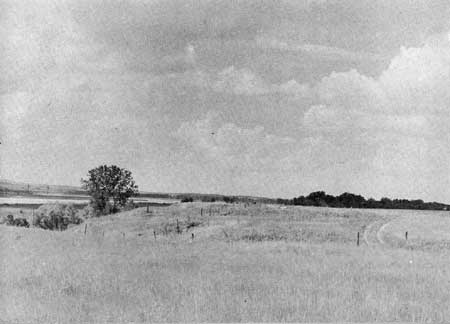|
The Upper Missouri Fur Trade Its Methods of Operation |
 |

1948 view, courtesy National Park Service
Stimulated by glowing reports of the newly-discovered fur-bearing regions on the Upper Missouri, Manuel Lisa, prominent St. Louis trader, in 1807, embarked on his first ambitious trapping expedition on the Upper Missouri. Inaugurating a new system of operating the business, he built strong permanent forts at strategic places where white hunters and trappers rendezvoused. These posts also served as trading houses and depositories for furs and peltries. This system was followed with some modification by the Missouri Fur Company, in which Lisa played a dominant part, Ramsay Crooks and Robert McClellan, and by later companies operating on the Upper Missouri.
In the decade and a half following the War of 1812 there was a sharp decline in the fur trade, following which there was a great revival in the business. The 1820's saw four strong outfits competing on the Upper Missouri—the Missouri Fur Company with Joshua Pilcher as one of its leading spirits; the Rocky Mountain Fur Company [3] supported by General William Ashley and Major Andrew Henry; the Columbia Fur Company backed by strong St. Louis interests and under the operation of former Northwest Company employees; and the Western Department, American Fur Company, organized in 1808 under the powerful leadership of John Jacob Astor and supported by the Chouteaus and other prominent French families in St. Louis. Within less than a decade after the merger of the two last companies in 1828, the new subsidiary firm, operating under the name of Upper Missouri Outfit, had driven its two other principal rivals and a number of lesser ones from the field.
Although frequently challenged, the Upper Missouri Outfit, generally called the American Fur Company, for the next three decades, monopolized the fur trade on the river. It was always known as "the company." Those competing against it, whether an individual trader or a powerful rival, were known as "the opposition."
By the early 1830's the company had a number of permanent trading posts on the Upper Missouri. In 1833 there were Cabanne's Post, located near Council Bluff, Forts Pierre, Clark, Union and McKenzie. All, with the exception of the first, were stockaded posts with bastions and were constructed to withstand attacks by strong war parties of Indians. Fort Pierre, located near the present city of Pierre, South Dakota, was the center of operations for the trading houses from Fort Union to Cabanne's Post. Fort Union, described by Nathaniel J. Wyeth in 1833 as "better furnished inside than any British fort I have ever" [4] and by Edwin T. Denig, well-known trader, ten years later as "the principal and handsomest trading post on the Missouri," [5] was situated near the mouth of the Yellowstone. This post had superintendence of the trade and served as a depot or storage house for the other establishments higher up on the Missouri and Yellowstone Rivers and in the mountains. [6] About 350 miles farther up the Missouri and below present Fort Benton, Montana was Fort McKenzie, which carried on the fur trade with the three Blackfoot tribes. [7] Each of these maintained a constant supply of articles used in the Indian trade. All of these principal posts were under the charge of an agent usually called a "bourgeois," who was responsible to the company for its operation. [8]
In addition to principal and subsidiary posts there were a number of wintering houses, which were usually block houses or log houses, at which three to six men were normally employed. These were usually erected for a winter among the Indian villages within the range of their trade and abandoned the following spring if the tribe moved to a new location. The furs from these places were sent to such depots as Forts Union or Pierre. [9]
The main permanent trading establishments were quite self-sufficient institutions. In 1833 the company had listed on its payroll, at Fort Union, 12 clerks and 129 men. [10] At this post the trades of tailor, gunsmith, blacksmith, tinner, cooper, carter, hunter and trapper were represented. Forts McKenzie and Pierre were equally self-supporting. McKenzie, Union, and Pierre all maintained herds of horses and cattle, which supplied the inmates with milk and butter. Both McKenzie and Union kept a small herd of swine. Forts Union, Pierre, and Clark all maintained gardens which supplied the fort employees with corn and vegetables. Nathaniel J. Wyeth, who made a trip down the Missouri in 1833, gave a good description of the garden at Fort Pierre:
[Sept.] 9th. Remained at the fort until about 1 ock. when we made by pulling 2 hours an Island 9 miles below the fort on which the Co. have about 15 acres of ground under cultivation here I remained all this day eating and drinking of the good things afforded by the earth and the cellars of the Co. Found cucumbers water & musk mellons beets carrots potatoes onions corn and a good cabin and the Company of Mr. Laidlow [sic] and Doct. [11]
Near Pierre, Union, and later Benton, were chantiers or boatyards where the company employed artisans to make and repair boats used in the trade. [12]

|

|
|
|
|
Last Modified: Sat, Jan 15 2005 10:00:00 am PDT |


